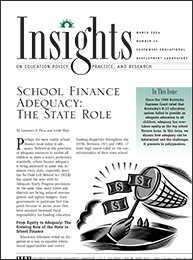Implementing and Evaluating the Adequacy Model
No matter which adequacy model is used, policymakers must resolve how prescriptive these models should be and how a model should be implemented. Once a set of resources has been specified, does it represent the way all districts should allocate those resources? Or does that set of resources provide a basis for a funding model that leaves it up to individual districts to ascertain how best to use those resources for improved student achievement? This is a difficult question. On the one hand, policymakers want to provide local school officials with as much flexibility to meet individual needs as possible. On the other hand, what should be done when a district or school receives these funds, elects to establish programs that are vastly different from the model used to determine funding levels, and then does not succeed? How this question is resolved will affect the success of adequacy models in every state, and it needs to be addressed up front and early in the discussions if meaningful reform is to occur.
 An important component of any adequacy system is continual evaluation, both to ensure that the level of funding remains adequate over time, and to be sure that it is achieving its goal of raising student performance. Certainly, improvements in student learning outcomes represent the most obvious way to evaluate the outcomes of school finance adequacy models, but knowing what schools and school districts purchase with new resources and how they translate those funds into student learning is essential to gain confidence that the amounts specified as adequate truly are, and that they remain adequate.
An important component of any adequacy system is continual evaluation, both to ensure that the level of funding remains adequate over time, and to be sure that it is achieving its goal of raising student performance. Certainly, improvements in student learning outcomes represent the most obvious way to evaluate the outcomes of school finance adequacy models, but knowing what schools and school districts purchase with new resources and how they translate those funds into student learning is essential to gain confidence that the amounts specified as adequate truly are, and that they remain adequate.
Despite the difficulties states face in determining adequate funding, accountability and adequacy hold great promise in making sure all children are given the opportunity and education to succeed. The challenges we must overcome to guarantee that every child receives an adequate education will be minor compared to the costs of not doing so.
Next Page: Web Resources

